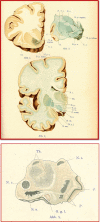A brief history of brain iron accumulation in Parkinson disease and related disorders
- PMID: 35534717
- PMCID: PMC9188502
- DOI: 10.1007/s00702-022-02505-5
A brief history of brain iron accumulation in Parkinson disease and related disorders
Abstract
Iron has a long and storied history in Parkinson disease and related disorders. This essential micronutrient is critical for normal brain function, but abnormal brain iron accumulation has been associated with extrapyramidal disease for a century. Precisely why, how, and when iron is implicated in neuronal death remains the subject of investigation. In this article, we review the history of iron in movement disorders, from the first observations in the early twentieth century to recent efforts that view extrapyramidal iron as a novel therapeutic target and diagnostic indicator.
Keywords: Parkinson disease; history of neuroscience; iron; substantia nigra.
© 2022. The Author(s).
Figures






Similar articles
-
Alterations in the levels of iron, ferritin and other trace metals in Parkinson's disease and other neurodegenerative diseases affecting the basal ganglia.Brain. 1991 Aug;114 ( Pt 4):1953-75. doi: 10.1093/brain/114.4.1953. Brain. 1991. PMID: 1832073
-
Anatomy and pathology of extrapyramidal diseases.Brain Res Bull. 1983 Aug;11(2):135-41. doi: 10.1016/0361-9230(83)90180-6. Brain Res Bull. 1983. PMID: 6226338
-
Implications of alterations in trace element levels in brain in Parkinson's disease and other neurological disorders affecting the basal ganglia.Adv Neurol. 1993;60:273-81. Adv Neurol. 1993. PMID: 8420143 No abstract available.
-
Neuroimaging in basal ganglia disorders: perspectives for transcranial ultrasound.Mov Disord. 2001 Jan;16(1):23-32. doi: 10.1002/1531-8257(200101)16:1<23::aid-mds1003>3.0.co;2-2. Mov Disord. 2001. PMID: 11215589 Review.
-
The history of the research of iron in parkinsonian substantia nigra.J Neural Transm (Vienna). 2012 Dec;119(12):1507-10. doi: 10.1007/s00702-012-0894-8. Epub 2012 Sep 2. J Neural Transm (Vienna). 2012. PMID: 22941506 Free PMC article. Review.
Cited by
-
Ferroptosis in central nervous system injuries: molecular mechanisms, diagnostic approaches, and therapeutic strategies.Front Cell Neurosci. 2025 Jul 22;19:1593963. doi: 10.3389/fncel.2025.1593963. eCollection 2025. Front Cell Neurosci. 2025. PMID: 40766185 Free PMC article. Review.
-
The Absence of Gastrointestinal Redox Dyshomeostasis in the Brain-First Rat Model of Parkinson's Disease Induced by Bilateral Intrastriatal 6-Hydroxydopamine.Mol Neurobiol. 2024 Aug;61(8):5481-5493. doi: 10.1007/s12035-023-03906-7. Epub 2024 Jan 10. Mol Neurobiol. 2024. PMID: 38200352 Free PMC article.
-
Iron dysregulation in mice engineered with a mutation associated with stuttering.bioRxiv [Preprint]. 2025 Jul 31:2025.07.30.667752. doi: 10.1101/2025.07.30.667752. bioRxiv. 2025. PMID: 40766684 Free PMC article. Preprint.
-
The heterogeneity of Parkinson's disease.J Neural Transm (Vienna). 2023 Jun;130(6):827-838. doi: 10.1007/s00702-023-02635-4. Epub 2023 May 11. J Neural Transm (Vienna). 2023. PMID: 37169935 Free PMC article. Review.
-
Is Mitochondrial DNA Copy Number from Human Blood Associated with Iron Deposits in the Brain?Antioxid Redox Signal. 2024 Jun;40(16-18):990-997. doi: 10.1089/ars.2023.0529. Epub 2024 Feb 23. Antioxid Redox Signal. 2024. PMID: 38251633 Free PMC article.
References
-
- Abbruzzese G, Cossu G, Balocco M, Marchese R, Murgia D, Melis M, Galanello R, Barella S, Matta G, Ruffinengo U, Bonuccelli U, Forni GL. A pilot trial of deferiprone for neurodegeneration with brain iron accumulation. Haematologica. 2011;96:1708–1711. doi: 10.3324/haematol.2011.043018. - DOI - PMC - PubMed
-
- Asenjo A. Cytosiderosis and iron deposits in ventrolateral nucleus of the thalamus in Parkinson's disease. Clinical and experimental study. Johns Hopkins Med J. 1968;122:284–294. - PubMed
Publication types
MeSH terms
Substances
LinkOut - more resources
Full Text Sources
Medical

